Abstract
The urinary excretion of the C5b-9 membrane attack complex of complement correlates with glomerular deposition of antibody in the passive Heymann nephritis (PHN) model of membranous nephropathy (MN). To determine if this parameter can be correlated with antibody deposition in a model of MN induced by an autologous mechanism and thus more analogous to human MN, the relationship of urinary C5b-9 to ongoing glomerular immune complex formation late in autologous immune complex nephritis (AICN) was studied. Based on urinary C5b-9, the animals were divided into two groups at 12 weeks after induction of AICN, those with persistently high urinary C5b-9 excretion and those in whom urinary excretion of C5b-9 returned to undetectable levels. While all rats developed glomerular deposition of rat IgG and significant proteinuria, high C5b-9 excretors had greater proteinuria and prolonged positive staining for glomerular C3. When normal syngeneic kidneys were transplanted into rats (n = 3) from each group, only those with persistent C5b-9 excretion developed subepithelial immune deposits of rat IgG in the transplanted kidney. As in the PHN model of MN, proteinuria was dissociated widely from urinary C5b-9 excretion, glomerular C3 staining, and evidence of circulating antibody. Thus these findings demonstrate that urinary excretion of C5b-9 serves as an index of on-going immunologic disease activity in the AICN model of MN, while proteinuria does not.
Full text
PDF

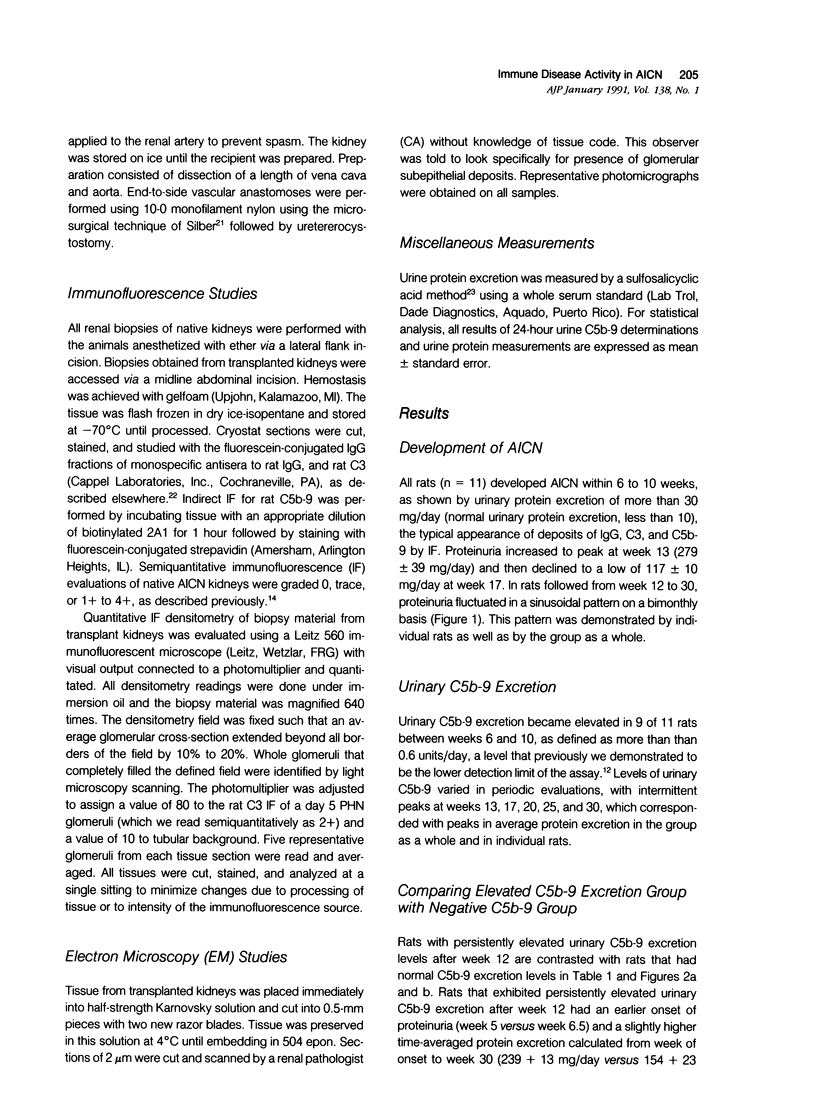
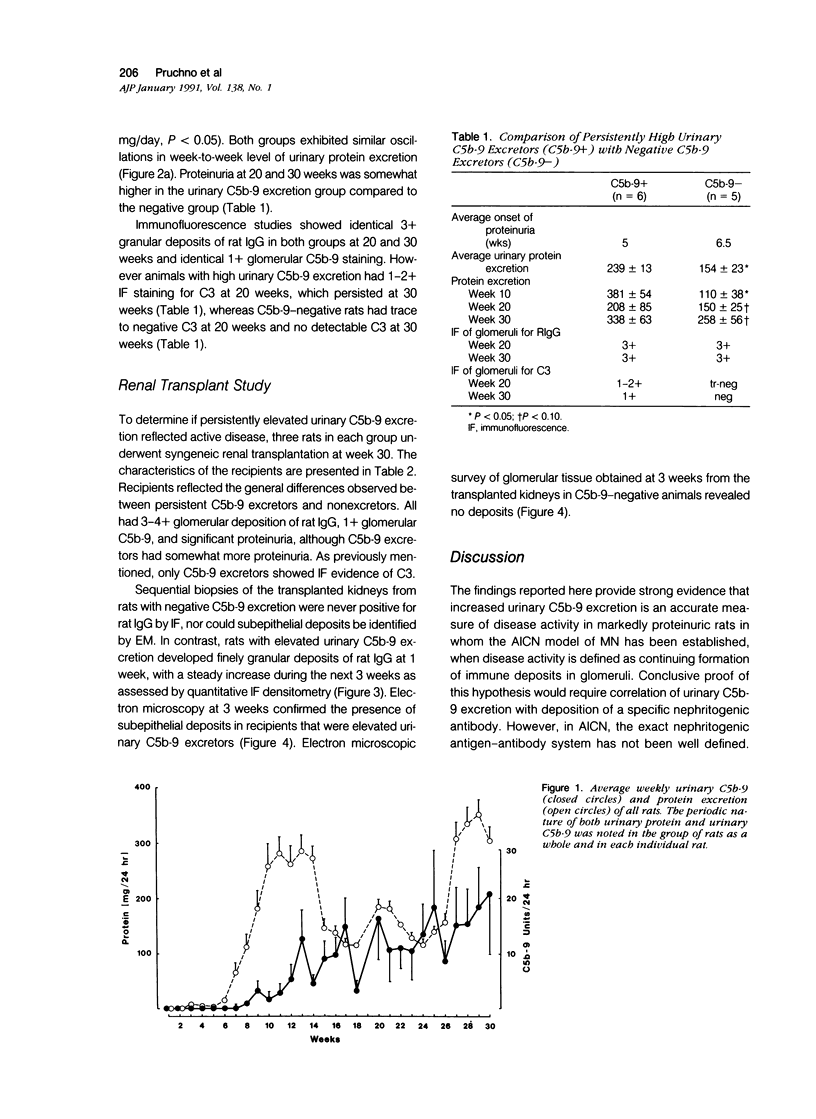

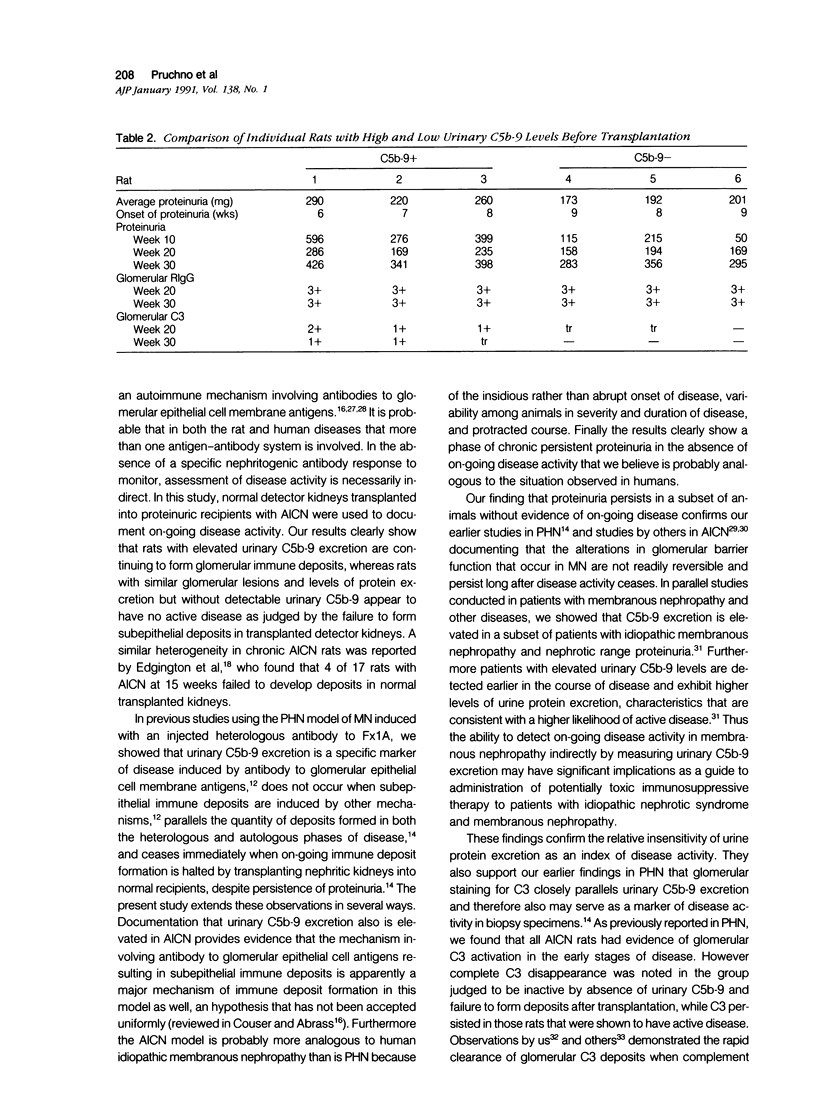
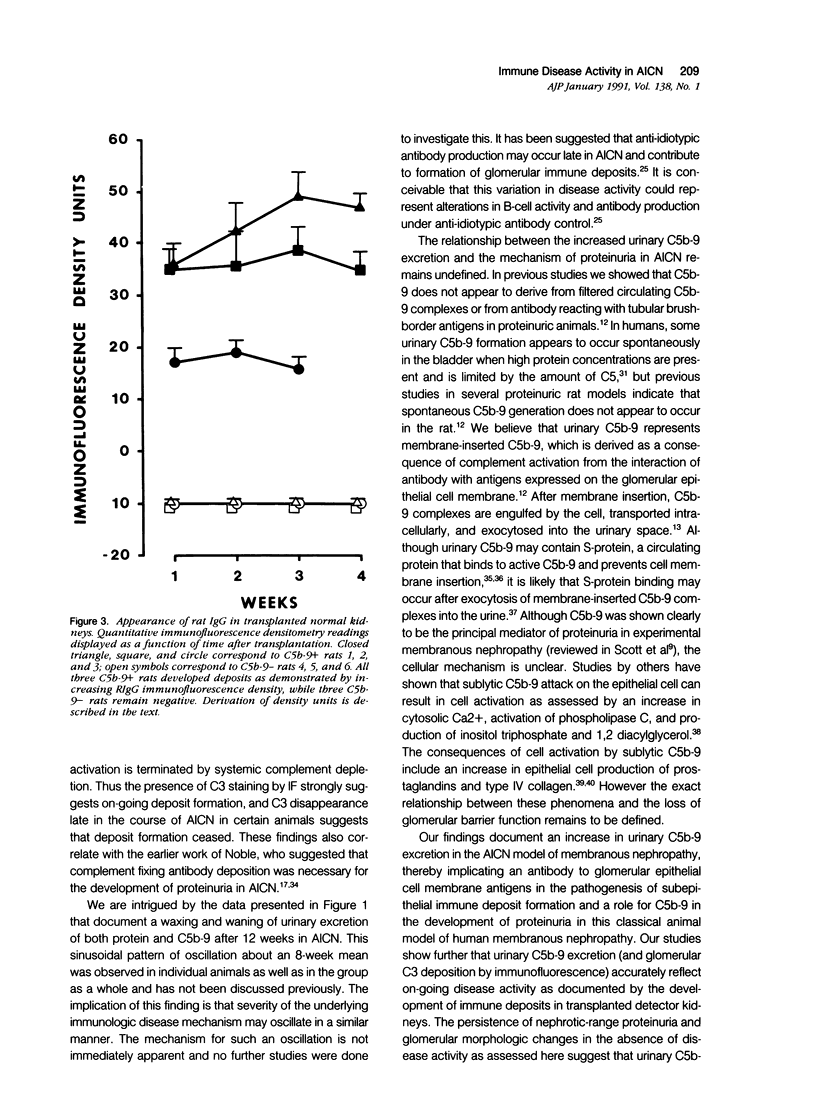

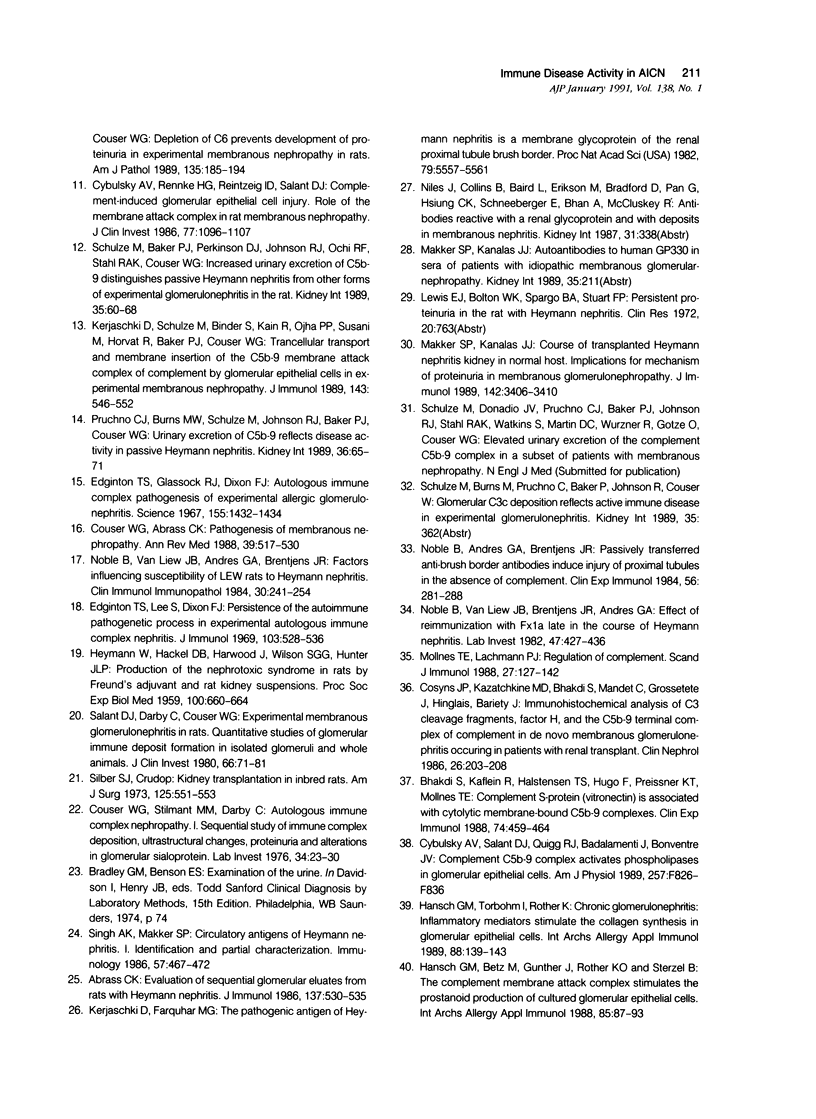
Images in this article
Selected References
These references are in PubMed. This may not be the complete list of references from this article.
- Abrass C. K. Evaluation of sequential glomerular eluates from rats with Heymann nephritis. J Immunol. 1986 Jul 15;137(2):530–535. [PubMed] [Google Scholar]
- Baker P. J., Ochi R. F., Schulze M., Johnson R. J., Campbell C., Couser W. G. Depletion of C6 prevents development of proteinuria in experimental membranous nephropathy in rats. Am J Pathol. 1989 Jul;135(1):185–194. [PMC free article] [PubMed] [Google Scholar]
- Bhakdi S., Käflein R., Halstensen T. S., Hugo F., Preissner K. T., Mollnes T. E. Complement S-protein (vitronectin) is associated with cytolytic membrane-bound C5b-9 complexes. Clin Exp Immunol. 1988 Dec;74(3):459–464. [PMC free article] [PubMed] [Google Scholar]
- Cattran D. C., Delmore T., Roscoe J., Cole E., Cardella C., Charron R., Ritchie S. A randomized controlled trial of prednisone in patients with idiopathic membranous nephropathy. N Engl J Med. 1989 Jan 26;320(4):210–215. doi: 10.1056/NEJM198901263200403. [DOI] [PubMed] [Google Scholar]
- Cosyns J. P., Kazatchkine M. D., Bhakdi S., Mandet C., Grossetete J., Hinglais N., Bariety J. Immunohistochemical analysis of C3 cleavage fragments, factor H, and the C5b-9 terminal complex of complement in de novo membranous glomerulonephritis occurring in patients with renal transplant. Clin Nephrol. 1986 Oct;26(4):203–208. [PubMed] [Google Scholar]
- Couser W. G., Abrass C. K. Pathogenesis of membranous nephropathy. Annu Rev Med. 1988;39:517–530. doi: 10.1146/annurev.me.39.020188.002505. [DOI] [PubMed] [Google Scholar]
- Couser W. G., Baker P. J., Adler S. Complement and the direct mediation of immune glomerular injury: a new perspective. Kidney Int. 1985 Dec;28(6):879–890. doi: 10.1038/ki.1985.214. [DOI] [PubMed] [Google Scholar]
- Couser W. G., Stilmant M. M., Darby C. Autologous immune complex nephropathy. I. Sequential study of immune complex deposition, ultrastructural changes, proteinuria, and alterations in glomerular sialoprotein. Lab Invest. 1976 Jan;34(1):23–30. [PubMed] [Google Scholar]
- Cybulsky A. V., Rennke H. G., Feintzeig I. D., Salant D. J. Complement-induced glomerular epithelial cell injury. Role of the membrane attack complex in rat membranous nephropathy. J Clin Invest. 1986 Apr;77(4):1096–1107. doi: 10.1172/JCI112408. [DOI] [PMC free article] [PubMed] [Google Scholar]
- Cybulsky A. V., Salant D. J., Quigg R. J., Badalamenti J., Bonventre J. V. Complement C5b-9 complex activates phospholipases in glomerular epithelial cells. Am J Physiol. 1989 Nov;257(5 Pt 2):F826–F836. doi: 10.1152/ajprenal.1989.257.5.F826. [DOI] [PubMed] [Google Scholar]
- Davison A. M., Cameron J. S., Kerr D. N., Ogg C. S., Wilkinson R. W. The natural history of renal function in untreated idiopathic membranous glomerulonephritis in adults. Clin Nephrol. 1984 Aug;22(2):61–67. [PubMed] [Google Scholar]
- Donadio J. V., Jr, Torres V. E., Velosa J. A., Wagoner R. D., Holley K. E., Okamura M., Ilstrup D. M., Chu C. P. Idiopathic membranous nephropathy: the natural history of untreated patients. Kidney Int. 1988 Mar;33(3):708–715. doi: 10.1038/ki.1988.56. [DOI] [PubMed] [Google Scholar]
- Edgington T. S., Glassock R. J., Dixon F. J. Autologous immune-complex pathogenesis of experimental allergic glomerulonephritis. Science. 1967 Mar 17;155(3768):1432–1434. doi: 10.1126/science.155.3768.1432. [DOI] [PubMed] [Google Scholar]
- Edgington T. S., Lee S., Dixon F. J. Persistence of the autoimmune pathogenetic process in experimental autologous immune complex nephritis. J Immunol. 1969 Sep;103(3):528–536. [PubMed] [Google Scholar]
- HEYMANN W., HACKEL D. B., HARWOOD S., WILSON S. G., HUNTER J. L. Production of nephrotic syndrome in rats by Freund's adjuvants and rat kidney suspensions. Proc Soc Exp Biol Med. 1959 Apr;100(4):660–664. doi: 10.3181/00379727-100-24736. [DOI] [PubMed] [Google Scholar]
- Hoorntje S. J., Kallenberg C. G., Weening J. J., Donker A. J., The T. H., Hoedemaeker P. J. Immune-complex glomerulopathy in patients treated with captopril. Lancet. 1980 Jun 7;1(8180):1212–1215. doi: 10.1016/s0140-6736(80)91677-3. [DOI] [PubMed] [Google Scholar]
- Hänsch G. M., Betz M., Günther J., Rother K. O., Sterzel B. The complement membrane attack complex stimulates the prostanoid production of cultured glomerular epithelial cells. Int Arch Allergy Appl Immunol. 1988;85(1):87–93. doi: 10.1159/000234479. [DOI] [PubMed] [Google Scholar]
- Hänsch G. M., Torbohm I., Rother K. Chronic glomerulonephritis: inflammatory mediators stimulate the collagen synthesis in glomerular epithelial cells. Int Arch Allergy Appl Immunol. 1989;88(1-2):139–143. doi: 10.1159/000234768. [DOI] [PubMed] [Google Scholar]
- Kerjaschki D., Farquhar M. G. The pathogenic antigen of Heymann nephritis is a membrane glycoprotein of the renal proximal tubule brush border. Proc Natl Acad Sci U S A. 1982 Sep;79(18):5557–5561. doi: 10.1073/pnas.79.18.5557. [DOI] [PMC free article] [PubMed] [Google Scholar]
- Kerjaschki D., Schulze M., Binder S., Kain R., Ojha P. P., Susani M., Horvat R., Baker P. J., Couser W. G. Transcellular transport and membrane insertion of the C5b-9 membrane attack complex of complement by glomerular epithelial cells in experimental membranous nephropathy. J Immunol. 1989 Jul 15;143(2):546–552. [PubMed] [Google Scholar]
- Makker S. P., Kanalas J. J. Course of transplanted Heymann nephritis kidney in normal host. Implications for mechanism of proteinuria in membranous glomerulonephropathy. J Immunol. 1989 May 15;142(10):3406–3410. [PubMed] [Google Scholar]
- Mollnes T. E., Lachmann P. J. Regulation of complement. Scand J Immunol. 1988 Feb;27(2):127–142. doi: 10.1111/j.1365-3083.1988.tb02331.x. [DOI] [PubMed] [Google Scholar]
- Noble B., Andres G. A., Brentjens J. R. Passively transferred anti-brush border antibodies induce injury of proximal tubules in the absence of complement. Clin Exp Immunol. 1984 May;56(2):281–288. [PMC free article] [PubMed] [Google Scholar]
- Noble B., Van Liew J. B., Andres G. A., Brentjens J. R. Factors influencing susceptibility of LEW rats to Heymann nephritis. Clin Immunol Immunopathol. 1984 Feb;30(2):241–254. doi: 10.1016/0090-1229(84)90059-x. [DOI] [PubMed] [Google Scholar]
- Noble B., Van Liew J. B., Brentjens J. R., Andres G. A. Effect of reimmunization with Fx1A late in the course of Heymann nephritis. Lab Invest. 1982 Nov;47(5):427–436. [PubMed] [Google Scholar]
- Ponticelli C., Zucchelli P., Passerini P., Cagnoli L., Cesana B., Pozzi C., Pasquali S., Imbasciati E., Grassi C., Redaelli B. A randomized trial of methylprednisolone and chlorambucil in idiopathic membranous nephropathy. N Engl J Med. 1989 Jan 5;320(1):8–13. doi: 10.1056/NEJM198901053200102. [DOI] [PubMed] [Google Scholar]
- Pruchno C. J., Burns M. W., Schulze M., Johnson R. J., Baker P. J., Couser W. G. Urinary excretion of C5b-9 reflects disease activity in passive Heymann nephritis. Kidney Int. 1989 Jul;36(1):65–71. doi: 10.1038/ki.1989.162. [DOI] [PubMed] [Google Scholar]
- Salant D. J., Darby C., Couser W. G. Experimental membranous glomerulonephritis in rats. Quantitative studies of glomerular immune deposit formation in isolated glomeruli and whole animals. J Clin Invest. 1980 Jul;66(1):71–81. doi: 10.1172/JCI109837. [DOI] [PMC free article] [PubMed] [Google Scholar]
- Schulze M., Baker P. J., Perkinson D. T., Johnson R. J., Ochi R. F., Stahl R. A., Couser W. G. Increased urinary excretion of C5b-9 distinguishes passive Heymann nephritis in the rat. Kidney Int. 1989 Jan;35(1):60–68. doi: 10.1038/ki.1989.8. [DOI] [PubMed] [Google Scholar]
- Silber S. J., Crudop J. Kidney transplantation in inbred rats. Am J Surg. 1973 May;125(5):551–553. doi: 10.1016/0002-9610(73)90136-0. [DOI] [PubMed] [Google Scholar]
- Singh A. K., Makker S. P. Circulatory antigens of Heymann nephritis. I. Identification and partial characterization. Immunology. 1986 Mar;57(3):467–472. [PMC free article] [PubMed] [Google Scholar]
- Törnroth T., Skrifvars B. The development and resolution of glomerular basement membrane changes associated with subepithelial immune deposits. Am J Pathol. 1975 May;79(2):219–236. [PMC free article] [PubMed] [Google Scholar]



